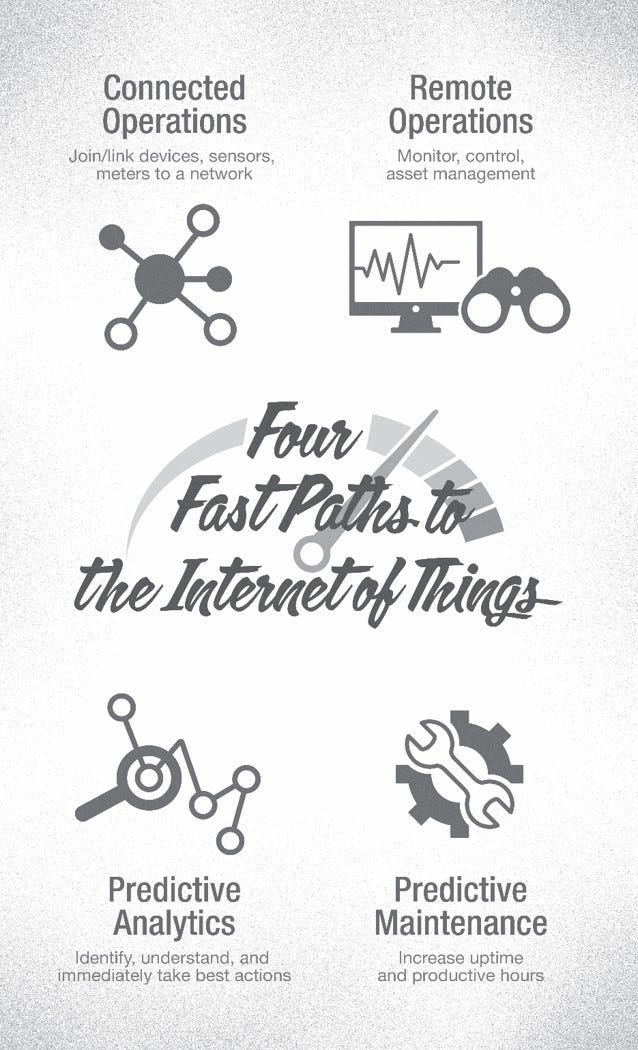How to Get Started with IoT and Generate Quick Returns on Your Investment
How to Get Started with IoT and Generate Quick Returns on Your Investment
- Last Updated: December 2, 2024
Maciej Kranz
- Last Updated: December 2, 2024



People often talk about deploying the Internet of Things (IoT) as if it’s a discrete project — something you do once, and then you move on to the next thing.
Nothing could be further from the truth.
IoT is a Multi-Year Journey, Not a One-Time Event
And like any journey, there are things you can do to speed yourself along the way and assure safe arrival.
As you embark on the IoT journey in your organization, changing culture may be your toughest challenge. So think of your task as not just implementing IoT solutions, but as a change management process that will likely transform your company.
Some will feel threatened by change, so make sure you have buy-in from stakeholders and support from the top. Break down silos, over-communicate, and check in often to make sure that everyone is along for the ride.
The best way to start on your IoT journey is with a small project that can generate immediate payback. If your organization’s leaders see that a small IoT investment pays off, they’ll be more willing to invest in larger, more strategic IoT implementations.
In this series of posts, I’ll discuss four “fast paths” to an assured IoT payback:

Generating Quick Returns on Your IoT Investment
One of the most important things to remember is to not fall in love with the technology, but focus on solving real business problems. These are the organization’s pain points, and they’re often well known.
So begin by arming yourself with your organization’s current data, benchmarks, and goals. Then start with the basics. If you can get IoT to enable a few devices to communicate and it removes or lessens a pain point, you stand to collect a significant payback without breaking the bank — or even much of a sweat.
It may, for example, take only a few connected temperature gauges to automatically alert someone to something getting too hot or too cold. Yet, having that information sooner, rather than later, could avoid a host of related problems and the costs that would follow.
Often, these types of solutions don’t require purchasing and deploying new devices and systems. They may very well be things the organization already has but haven’t yet connected for this purpose.
Another potential early win involves remote operations.
How often do you have processes that require someone to stop by and shake a door or check a meter?
With IoT, you can monitor processes like these, perform the required action, and avoid dispatching a person (or two) to do the job. You collect your payback every time somebody doesn’t have to perform these tasks, because an IoT connected device enables you to do it remotely.
To sum it up, implementing the right IoT solution can give you fast payback in the following four areas:
- Increased productivity: Wherever IoT can perform a task that somebody otherwise would have to do, you have an immediate win that compounds itself by speeding up processes and freeing up your staff to do other work.
- Lower costs. Wherever devices can connect and communicate to automate a process, you stand to lower your costs.
- Improved quality. Wherever you can use intelligent devices connected and communicating through IoT, you can avoid or at least reduce errors, which will increase process quality.
- Better, faster decision making. Whenever you capture the information your devices are collecting and communicating through IoT, your staff are positioned to make better decisions. If you add some analytics or predictive analytics into the equation, more and better decision making can be done even faster. Your managers need only pay attention to the exceptions.
Okay, So How Do You Get There?
Over the past decade, I have taken my own IoT journey — visiting dozens and dozens of companies around the world to work with them and learn from them as they implement IoT. Based on their experiences, a set of best practices has emerged:
Best Practices:
- Have a big vision, but start with a small project using one of the four fast payback scenarios I will discuss in this series.
- Build your own business case by comparing industry benchmarks with your own total cost of ownership data.
- Get a C-suite sponsor, because you aren’t implementing one IoT project, you’re starting on the journey that will transform your organization, your industry, and your career.
- Build a cross-functional team; you need complementary skills, so maximize the chances of success by building a cross-organizational team to ensure support and buy-in across your entire organization. You’ll also bring in an ecosystem of partners for a complete, converged solution.
Along the way, you’ll break down silos and build understanding and cooperation among IT, OT, supply chain and finance. And you just may find yourself on the path to creating transformational change in your organization.
Stay tuned as we dive deeper to each of the four fast paths to IoT value. First up: Connected Operations. And please share your thoughts in the comments below or on Maciej's Building the Internet of Things community.
The Most Comprehensive IoT Newsletter for Enterprises
Showcasing the highest-quality content, resources, news, and insights from the world of the Internet of Things. Subscribe to remain informed and up-to-date.
New Podcast Episode

Why Multi-Network SIM is a Game Changer for IoT
Related Articles


